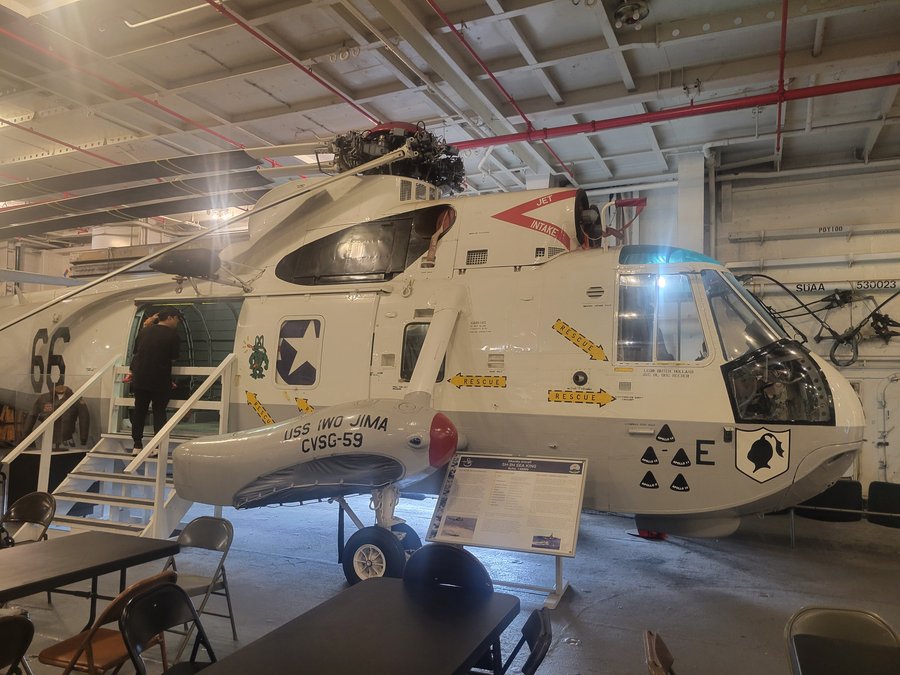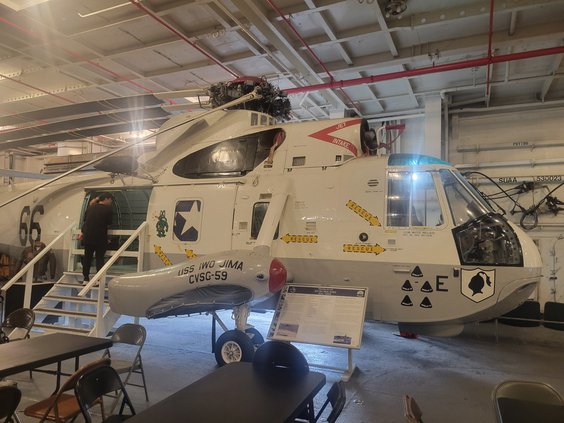

ALAMEDA — The USS Hornet — an aircraft carrier that saw service in the Pacific Theatre of World War II, the Cold War, the Vietnam War, and finally as part of NASA’s Apollo program — is now one of the most unusual museums in the San Francisco Bay Area.
The Museum is located at historic Pier 3 in Alameda.
The pier was part of the Alameda Naval Air Station that was active from 1940 until 1997.
In April 1942, the top-secret Doolittle Raid left from the very same pier.
In an average year, over 60,000 visitors come to the Museum.
They come to step into history and learn about the long service of the ship that spanned from 1943 to 1970.
The Museum is open Friday through Monday from 10 a.m. to 5 p.m.
Tickets are $25 for adults, $15 for seniors and students, $12 for youth ages 7 to 17, and free for those 6 and under.
Parking is free.
Information and the purchase of tickets can be done via the website, uss-hornet.org.
Visitors learn about how sailors lived, the aircraft they flew, the recovery of the Apollo 11 and 12 astronauts, and more.
The Hangar Deck, Flight Deck, and 2nd Deck are open for self-guided tours.
Lower decks and the Island super-structure can be accessed as part of guided tours and include the engine room, catapult systems, and much more.
The Museum has robust education programming and works with schools from all over the Bay Area.
About the USS Hornet
The USS Hornet was part of a wartime buildup of U.S. carrier forces in a war that demonstrated the vital role of naval aviation.
As early as 1910, the U.S. Navy recognized the potential value that flight would have in naval operations.
Although naval aviation was utilized during World War I, aircraft assigned to warships generally provided only reconnaissance support for the fleet.
The possibility of using airplanes as a naval strike weapon did not begin until the 1920s when aircraft capable of performing heavy bombardment against land or sea targets were built.
Naval vessels capable of carrying several squadrons of such aircraft were developed concurrently.
The first eight carriers constructed by the U.S. Navy varied in size, speed, protection and aircraft complement to provide the greatest number of carriers capable of launching the greatest number of air strikes, yet still comply with treaty-imposed tonnage restrictions.
Essex (CV-9), the ninth U.S. carrier authorized, was a product of these earlier designs.
A total of 26 Essex-class carriers were ordered by the U.S. Navy between February 1940 and June 1943 and 24 were completed.
This was the largest class of carriers ever built by the United States and over half, including USS Hornet (CV-12), served as part of the Pacific Fleet during World War II.
World War II and the carrier campaigns of the Pacific firmly established the role of aviation within naval operations and the aircraft carrier replaced the battleship as the Navy’s primary strike weapon.
Serving as mobile air bases, carriers could maneuver aircraft around the open waters and scattered island chains of the Pacific.
By employing a combination of scouting, fighter or bomber aircraft to control the enemy’s air power, groups of carriers, screened by surface ships, could open the way for island invasions, cover and support amphibious operations, and help to hold the conquered areas.
Thus carriers became an integral compound of nearly every campaign throughout the Pacific War. With aircraft that extended the fleet’s firepower beyond the range of large caliber battleship guns, the carrier’s status was elevated from reconnaissance platform to that of major surface combatant.
Launched just 10 months after its predecessor, the USS Hornet (CV-8), was lost in battle.
The new Hornet had a distinguished World War II career that included the invasion of Saipan and the Battle of the Philippine Sea, the amphibious landing on Palau, the Philippines, Iwo Jima and Okinawa and strikes against the Japanese home islands.
The USS Hornet and its air groups were credited with shooting down 688 planes, destroying another 742 aircraft on the ground, sinking a carrier, cruiser, 42 cargo ships and 10 destroyers and assisting in the sinking of the Japanese battleship Yamato.
The Hornet received seven battle stars and the Presidential Unit citation during World War II.
The USS Hornet was reactivated for the Korean War and its last combat deployment was as an antisubmarine warfare carrier in the Vietnam War.
The USS Hornet’s exceptional career was capped with the recovery of the Apollo 11 and Apollo 12 astronauts at the end of these missions.
Navy divers aided the Apollo 11 crew, astronauts Neil A. Armstrong, Edwin E. Aldrin, Jr. and Michael Collins, back to the Hornet after the capsule hit the water. The Apollo crew, wearing containment suits because of the possibility of introducing alien bacteria, stepped from the helicopter, waved and entered quarantine. President Richard M. Nixon welcomed the astronauts back to earth aboard the carrier. “Hornet plus three” then steamed for home. The Navy announced the impending retirement of the USS Hornet on Jan. 15, 1970, and the carrier was decommissioned on June 30 of that year.
Today the USS Hornet is open to the public and permanently moored at the former Alameda Naval Air Station, which served many functions during World War II, providing combat training to carrier squadrons, commanding patrol and scouting operations, and providing aviation support for Naval supply bases.
Alameda was a major aviation gateway to the Pacific and berthing location for the Pacific fleet, including the first USS Hornet.







